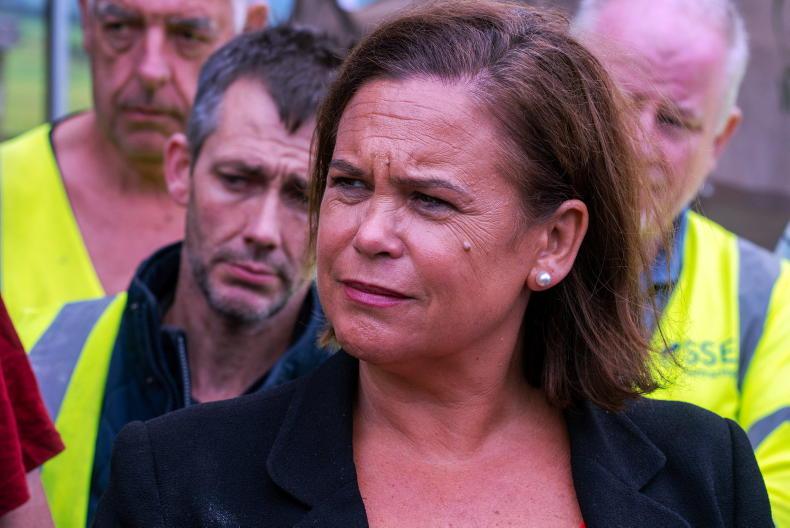“I don’t know what a tracker mortgage is” the man on the bus used to proclaim. Anyone remember that ad for the Financial Regulator?
Decades before, as Ireland switched from the imperial measuring system to metric, a man in an ad asked in a hardware shop “could you show me a metre?”.
Measuring is a relative process.
On The Week in Politics, Sinn Féin leader Mary Lou McDonald repeatedly spoke of the need to prioritise “family farms”, differentiating them from “hyper-intensive” farms.

Sinn Féin leader Mary Lou McDonald. \ Barry Cronin
Matt Carthy, the party’s agriculture spokesperson, has used similar language. Sinn Féin seems destined to lead the next Government, so what is meant by these terms?
An Taisce recently held a seminar to discuss “intensive agriculture” and the environment. We also increasing hear people refer to “industrial farming”, “factory farming” and “Big Ag”.
The question is, what do they actually mean?
These terms are becoming reference points in the public debate for how we frame farming’s future.
The question is, what do they actually mean? Perhaps that is the advantage of them, that they can mean completely different things depending on who is saying them, or even perhaps depending on who is listening.
Does any of this matter? It might matter a lot. When opinion formers and politicians constantly draw a line somewhere between family farms and other farms, they are inferring that there is good farming and bad farming. And they are inferring that the difference between good farming and bad farming is scale and intensity.
It’s a false narrative in terms of Irish farming
Small, lowly stocked farms are perceived as family farms and good. Larger farms are perceived as “intensive” industrial factory farms.
It’s a false narrative in terms of Irish farming.
The average farm is 32ha, (that’s 75 acres to the man in the hardware shop). According to the CSO, there were fewer than 5,000 farms over 100ha in 2016. In case anyone thinks these are all billionaire ranchers, consider this. Many of these larger farmers are tillage farmers.
Teagasc reckons that a tillage farmer needs to be farming 200ha to earn the average industrial wage.
Many are renting a substantial proportion of their holdings.
Some smaller, less-stocked farms are owned by people with other income streams. Which is the family farm?
Most larger farms are facing significant CAP payment cuts.
Many larger, more intensive farms are providing an income to two generations who live and work on the farm.
Some smaller, less-stocked farms are owned by people with other income streams. Which is the family farm?
In order to have a plan to maintain the viability of family farms as we address sectoral carbon targets, we first need to agree what a family farm is and isn’t.
If we don’t ask now what a family farm is, in a few years we might be remembering what a family farm was.
“I don’t know what a tracker mortgage is” the man on the bus used to proclaim. Anyone remember that ad for the Financial Regulator?
Decades before, as Ireland switched from the imperial measuring system to metric, a man in an ad asked in a hardware shop “could you show me a metre?”.
Measuring is a relative process.
On The Week in Politics, Sinn Féin leader Mary Lou McDonald repeatedly spoke of the need to prioritise “family farms”, differentiating them from “hyper-intensive” farms.

Sinn Féin leader Mary Lou McDonald. \ Barry Cronin
Matt Carthy, the party’s agriculture spokesperson, has used similar language. Sinn Féin seems destined to lead the next Government, so what is meant by these terms?
An Taisce recently held a seminar to discuss “intensive agriculture” and the environment. We also increasing hear people refer to “industrial farming”, “factory farming” and “Big Ag”.
The question is, what do they actually mean?
These terms are becoming reference points in the public debate for how we frame farming’s future.
The question is, what do they actually mean? Perhaps that is the advantage of them, that they can mean completely different things depending on who is saying them, or even perhaps depending on who is listening.
Does any of this matter? It might matter a lot. When opinion formers and politicians constantly draw a line somewhere between family farms and other farms, they are inferring that there is good farming and bad farming. And they are inferring that the difference between good farming and bad farming is scale and intensity.
It’s a false narrative in terms of Irish farming
Small, lowly stocked farms are perceived as family farms and good. Larger farms are perceived as “intensive” industrial factory farms.
It’s a false narrative in terms of Irish farming.
The average farm is 32ha, (that’s 75 acres to the man in the hardware shop). According to the CSO, there were fewer than 5,000 farms over 100ha in 2016. In case anyone thinks these are all billionaire ranchers, consider this. Many of these larger farmers are tillage farmers.
Teagasc reckons that a tillage farmer needs to be farming 200ha to earn the average industrial wage.
Many are renting a substantial proportion of their holdings.
Some smaller, less-stocked farms are owned by people with other income streams. Which is the family farm?
Most larger farms are facing significant CAP payment cuts.
Many larger, more intensive farms are providing an income to two generations who live and work on the farm.
Some smaller, less-stocked farms are owned by people with other income streams. Which is the family farm?
In order to have a plan to maintain the viability of family farms as we address sectoral carbon targets, we first need to agree what a family farm is and isn’t.
If we don’t ask now what a family farm is, in a few years we might be remembering what a family farm was.







 This is a subscriber-only article
This is a subscriber-only article










SHARING OPTIONS: